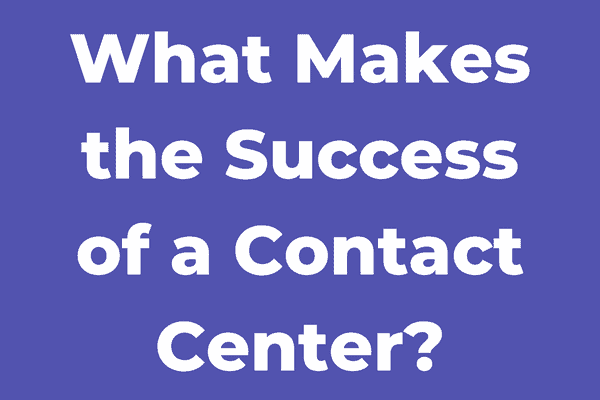Success is a concept whose meaning varies from person to person. It is purely subjective and can mean a myriad of things, as what is considered successful for one person may not be the same for the other. On a broad scale, success is defined as achieving a desired goal or outcome, either on a personal or a professional level.
In our sphere, a successful contact center is defined by its ability to manage customer interactions and meet their needs, while also operating in an efficient and cost-effective manner.
To become a successful contact center, managers should pay exhaustive attention to four aspects, the first of which is a well trained workforce. Agents who possess excellent communication skills and product knowledge, able to provide seamless interactions.
The second is an advanced technological solution to effectively manage customer interactions, streamline processes, and enable data-driven decision making.
The third element is processes, which need to be streamlined to achieve the highest efficiency levels. And finally, metrics, which constitute the cornerstone for every decision, and a key element to be able to analyze, track, and measure success.
In this article, we will elaborate on the key elements that underlie the success of contact centers. We will also explore best strategies to optimize contact center operations, potential challenges, and best practices to overcome them.

Key elements of a Successful Contact Center:
Contact Center Technology Solutions
Without a fertile terrain, no plant can fully develop. The same thing applies to success in contact centers. Managing customer needs and providing a satisfying experience can become a hassle without the proper technology.
With a proper omnichannel contact center solution like Omni+ you can improve agent performance, enhance the customer experience, and increase operational efficiency, ultimately driving business success. All are available through a single interface on a web browser to handle all customer interactions, including voice, web chat, email, and social media.
Another aspect of our cloud-based solution is scalability and flexibility, allowing easy capacity adjustments to suit the changing demand.
Additionally, proper technology provides a knowledge management system that offers access to updated product/service information and policies. Helping agents provide accurate information to customers, reduces their frustration and enhances their experience.
Contact Center Agents
To ensure the success of your contact center, you must put effort in training agents. They are the front line of customer interactions and directly impact the customer experience. Ensuring that they are well-equipped to provide exceptional service is essential.
In the hiring process, it is important to look for individuals with strong communication skills and problem-solving abilities. Aligning with the organization’s culture and values also helps reduce turnover rates, and improves job satisfaction.
Training is of equal importance, as it covers a range of topics related to product/service knowledge and customer service best practices. Enabling agents to provide accurate information, and efficiently resolve customer inquiries.
Ongoing development is also important, as it help agents keep up with changing policies and procedures, which improves their skills and performance.
And as the old adage states that to do a good job, you need the right tools, it also applies to agents. It does not matter if you have the best workforce, if you miss the right tool for it to achieve its full potential. This does not rely solely on the technology solution, but also access to a knowledge base, scripts for the recurring interactions, and feedback from supervisors.
Finally, it is of an extreme importance to create a supportive and positive work environment. As it improves agents’ job satisfaction and reduces turnover. To instore a positive work culture, you can provide career advancement opportunities, recognize and reward outstanding performances, and foster a sense of community.
Processes
Contact centers can greatly improve their efficiency and reduce their operating costs by optimizing processes and workflows.
One way to achieve that is implementing self-service options. As self-service customer experience enhances customer satisfaction and increases efficiency, it is becoming increasingly critical for contact centers’ success. When customers easily access solution to their problems, their satisfaction improves, which eventually appreciates their loyalty.
Self-service options also increases contact centers’ efficiency by reducing the workloads of live agents. Making them available to handle more complex issues, and consequently reduce wait times for other customers. Which can also be achieved by using data analytics and customer history to route inquiries to the appropriate agent.
Additionally, self-service options are available 24/7, providing customers with the flexibility to get help whenever they need it.
Continuously evaluating and improving processes is essential to assure ongoing success. By keeping an eye on metrics such as call volume, wait times and CSAT, managers can identify areas for improvement and implement changes where needed. Thus, becoming a successful contact center.
This brings us to our final yet prominent key element to contact centers’ success.
Key Performance Indicators
Probably one of the most important elements used in tracking performance and success, not only for the contact center industry but also in numerous other industries, are the KPI’s or Metrics.
On one hand, reporting refers to data collection on various metrics, such as customer satisfaction, call volume, agent performance, and other relevant KPI’s. Presented using reports to monitor a contact center’s performance over time. On the other hand, analytics refers to the use of advanced tools and techniques to analyze the collected data. It is pivotal to contact centers as it provides deeper insights that will help identify trends and improvement areas that might be inconspicuous from the raw data.
In tandem, reporting and analytics help managers make data-driven decisions that improves a contact centers’ performance and reduce costs. Additionally, they help identify improvement areas, and ensure that the strategic goals are met.
We extensively cite the important metrics to track for contact centers in our 7 KPI’s for excellent customer service guide. Nevertheless, here are some of the most common key metrics:
-
-
CSAT
-
The Customer Satisfaction Score is a popular metric used by call centers to assess buyer satisfaction. It instantly collects “on-the-spot” comments after a purchase experience or engagement with the brand to offer real-time client feedback. The CSAT is based on the customer’s emotions, as opposed to the NPS, which is intended to provide a more reasonable perspective.
-
-
FCR
-
First Call Resolution is a KPI that evaluates the percentage of issues addressed on the first phone conversation. Customers like having their concerns handled quickly, and addressing them in a single call not only promotes satisfaction but also saves call center resources. To calculate CRF, divide the total number of customer concerns reported in the same time period by the number of issues addressed in one call.
This measure is strongly connected to AHT: if AHT falls but FCR rises, it indicates that client calls are not being handled satisfactorily.
-
-
AHT
-
AHT is an abbreviation for Average Handling Time. It is one of the most typical criteria assessed in contact center support services. As it reflects the average duration of a customer engagement, which is generally calculated from the beginning of the call and includes the full discussion and hold time to the end of the call.
In general, contact centers aims to minimize AHT. Both to decrease operational expenses (the shorter the AHT, the more calls may be handled) and to deliver the most efficient user experience possible.
By tracking and analyzing metrics, managers can evaluate and improve their strategy, to achieve greater efficiency and higher customer satisfaction.

Common Challenges in Contact Center Operations
High Agent Turnover
Agents are the façade of customer service, which makes them a high priority aspect to provide an excellent customer experience. According to Forbes although ”high employee turnover rates” decrease productivity, reduce customer satisfaction, and indirectly increases recruitment and training costs.
One of the major factors that influences turnover rates is job stress. Agents often face long hours with high call volumes and repetitive tasks which leads to burnout and dissatisfaction.
One strategy to remedy this is to improve the work environment. By offering schedule flexibility, rewards, and career development opportunities, managers can improve job satisfaction, and reduce burnout.
Another approach is to improve the onboarding process and equip agents with the right tools and technology. By providing comprehensive training and support, and also tools to help agents handle inquiries, agents will feel more effective in their job, and more confident in their roles.
Finally, feedback and regular communication are of critical importance. Managers help agents feel valued and supported in their roles by routinely providing performance feedback and addressing concerns and issues promptly. Thus, becoming a successful contact center.
Poor technology infrastructure
Contact centers depend dejectedly on technological infrastructure to handle inquiries, manage data, and communicate with the customers. When the technology used is outdated, or defective in any way, it leads to endless issues that impacts both the customer, and the agent.
One of the prominent issues with poor technological infrastructure in a contact center is downtime. When the system is down, agents cannot respond to inquiries or access customer information. Which leads to frustrated customers, and revenue loss for the contact center.
Another issue lies in the inability to integrate with other systems and technologies. As customer service is becoming increasingly omnichannel, contact centers need to be able to integrate with different systems such as CRM platforms, chatbots, and social media. This aspect is primordial when it comes to meeting customers’ expectations and standing nose to nose with competition.
One solution for this is to invest in a modern solution, such as NobelBiz’s OMNI+, able to handle high volumes of enquiries, and easily integrate with other systems. Another strategy is to outline a technology roadmap that reflects the organization’s priorities and goals in this aspect. It should include plans for upgrading existing systems, and implementing new ones as needed.
Regular technology assessments are mandatory in order to ensure that the systems are functioning optimally.
Inconsistent Customer Experience
Customers expect consistency in their experience, regardless of which channel they interact with. Nevertheless, when contact centers fail to deliver it, it impacts negatively the customer experience and increases their frustration.
One of the primary causes of inconsistent customer experiences is a lack of training and knowledge among agents. If agents are not trained on the organization’s products, services, and processes, they may provide incorrect information to customers, leading to frustration and dissatisfaction. Additionally, if agents are not trained to handle a variety of customer inquiries and issues, customers may be transferred multiple times or have to repeat their inquiries, leading to a poor experience.
One of the main reasons for inconsistent customer experiences is the lack of knowledge and training among agents. If agents are not fully knowledgeable about the company’s product and services, they will provide inaccurate information for the customers. Which will increase their frustration and dissatisfaction. Moreover, when agents are not trained to handle multiple inquiries, customers may be continuously transferred or have to repeat their inquiries. Which could be troublesome.
Another cause of inconsistency is the lack of integration between different channels. When a customer reaches out to support across multiple channels, such as email and phone, they expect seamless handling across all channels. However, when these channels are not integrated, it leads to a disjointed communication, and thus a negative experience.
To address this, contact centers need to implement a knowledge base to standardize processes and procedures across all channels. And accessible to all agents for consistent and accurate information.
Another strategy consists of providing ongoing training and development for agents. Training can include product and service knowledge, but also soft skills such as active listening and empathy.
Investing in training and agent development, managers directly improve service quality, and reduce inconsistency recurrences.
Inefficient Call Center Processes
One of the prominent causes of inefficient processes is the lack of standardization across channels and agents. When agents handle inquiries in different manners, it leads to confusion not only for customers, but also for other agents. Additionally, when processes are not automated when they should, it leads to unnecessary manual work for agents. And also, longer wait times for customers, and inaccuracy in resolving inquiries.
Another cause is the lack of data analysis. If contact centers don’t track and measure indicators such as handling time and customer satisfaction, they may fail to identify improvement areas. And also, if they do not have a continuous improvement culture, they will fail to implement changes that could lead to more efficient processes.
One strategy to remedy this is to leverage automation to streamline processes whenever possible. This includes using chatbots for recurrent inquiries, intelligently routing inquiries to specific agents. And also, personalizing interactions based on customer data.
By regularly reviewing metrics, and fostering a continuous improvement culture, managers identify inefficiencies and address them. And also, optimize processes to enhance the customer experience.
4 Strategies for Optimizing Contact Center Operations:
-
Identify Customer Pain Points
Customer Pain Points represent issues or problems customers experience when they interact with a contact center. By identifying these pain points, managers can address them and improve their processes to enhance the customer experience.
One way to identify said points is to listen to the customers. Through feedback, surveys and social media comments, managers can know exactly what causes the malaise. Another is to monitor interactions, such as calls and chat transcripts.
Data analytics is also valuable, as it helps identify patterns in customer interactions by analyzing metrics such as wait times and call volumes.
Once the pain points are identified, managers can take steps to remedy them. This involves process changes, training, and technology. By addressing customer pain points, contact centers show to their clientele that they listen and address their specific inquiries. Which makes the customers feel valued, and have a positive experience. Thus, becoming a successful contact center.
-
Implement Self-Service Options
Self-service customer experience is the ability of customers to resolve their issues on their own, without the need to speak to a person. It constitutes a significant aspect of customer experience management as it allows customers to find answers to their questions and resolve issues quickly and conveniently.
As self-service customer experience enhances customer satisfaction and increases efficiency, it is becoming increasingly critical for contact centers’ success. When customers easily access solutions to their problems, their satisfaction improves, which eventually appreciates their loyalty.
Self-service options also increase contact centers’ efficiency by reducing the workloads of live agents. Making them available to handle more complex issues, and, consequently, reduce wait times for other customers.
Additionally, self-service options are available 24/7, providing customers with the flexibility to get help whenever they need it.
By offering self-service options, contact centers help empower customers to take control over their own experience. This leads to a positive outcome, making customers more self-reliant and thus increasing their satisfaction.
-
Invest in Agent Training
When agents have the necessary skills, their interactions become short and seamless, improving customer experience, and reducing call volumes.
Agent training can be provided in numerous ways. Including classroom training, online training, on-the-job training, and coaching. Additionally, it helps agents develop skills such as customer support, communication skills, problem-solving, and technical proficiency.
Training is beneficial in the way that trained agents to provide better service, which leads to increased overall customer satisfaction. They can resolve issues more efficiently, thus reducing wait times and curtailing call volumes.
Training also improves agent satisfaction and makes them feel valuable and more confident in their roles. Which consequently reduces turnover rates, resulting in cost savings for the contact center.Thus, becoming a successful contact center.
-
Measure Key Metrics
Identifying the relevant Agent Performance Indicators ensures that the contact center is tracking the right metrics. They should directly link to the fixed goals and objectives, which emphasizes the fact that they need to be carefully selected.
Moreover, KPI’s provide a consistent framework for measuring performance to track progress over time, identify trends, and make data-driven decisions. Which helps contact centers pinpoint their strength and weakness areas.
The most important metrics to measure vary depending on the contact center’s goals and objectives, but some common metrics include:
- Average Handle Time (AHT): This metric measures the average time agents spend handling calls, including hold time, talk time, and after-call work. It is a key indicator of contact center efficiency.
- First Call Resolution (FCR): This metric measures the percentage of calls that are resolved on the first call, without the need for follow-up.
- Customer Satisfaction (CSAT): This metric measures how satisfied customers are with their interactions with the contact center.
- Net Promoter Score (NPS): This metric measures how likely customers are to recommend the contact center to others.
- Service Level: This metric measures the percentage of calls answered within a specific period.
By measuring these metrics, managers gain insights into the customer experience, agent performance and operations. By tracking and analyzing data, it is possible to identify improvement areas and make data-driven decisions.
Keep in mind that the metrics chosen should align with the organization’s fixed goals and objectives. So that the analysis helps makes decisions that would improve the contact center’s success.

7 Best Practices for a Successful Contact Center
-
Prioritize Customer Experience
By adopting a customer-centric approach, contact centers can improve customer satisfaction and drive business growth. To achieve it, managers should focus on some aspects such as personalization. Which enables building rapport and establishing trust. Showing empathy and being an active listener also helps build stronger relationships and improve customer satisfaction.
Responding promptly and in a timely manner helps improve the FCR, which increases loyalty and satisfaction.
Finally, offering omnichannel support, and actively gathering customer feedback can provide a seamless experience for the customers. And also helps contact centers stay ahead of the competition. Thus, becoming a successful contact center.
-
Foster a Positive Work Culture
Contact center managers can improve employee morale and engagement by promoting a positive work environment.
One way to achieve this is through open communication channels where employees are encouraged to share their ideas. Recognition and rewards are also favored as they acknowledge employees’ achievements.
Another way is to promote a work-life balance to reduce burnout and job dissatisfaction. Leading to increased employee retention rates and reduced turnover rates.
Moreover, professional development programs and team-building activities can help employees sharpen their skills. And create a sense of community and collaboration in the organization.
-
Continuously Evaluate and Improve Processes
To remain competitive, contact centers must keep up with technological advancements, and evolving customer expectations. This is achievable through customer feedback analysis, including complaints and metrics, to pinpoint weakness areas and remedy them.
Additionally, data and analytics and quality assurance play a crucial role too. As they allow to identify efficiencies and monitor performances to ensure that processes are correctly followed.
Throughout the continuous evaluation and improvement of processes, contact centers enhance their operations, improve the customer experience, and remain competitive in the market. Thus, becoming a successful contact center.
-
Develop a comprehensive Strategy:
A comprehensive strategy must take into account the ever-changing customer needs and preferences. And the evolving technological landscape. It should also take into account identifying the right audience and segmenting customers to better tailor services to meet their specific requirements.
Another essential component of a well-thought-of strategy is ongoing training and development. Without it, agents would languish trying to handle customer inquiries and situations. Which would be detrimental to the customer experience, and, consequently the contact center operations.
In addition, adopting a disaster recovery plan and ensuring data security is a critical component of a contact center strategy. Thus, building a successful contact center.
-
Invest in the right technology:
Today’s customers demand speed and efficiency when interacting with support agents. Investing in the right technology is a must to meet these expectations. Armed with the right technology, contact centers can streamline their processes, allowing them to improve the customer experience and refine operational efficiency.
One primordial aspect is a cloud-based contact center software, such as our OMNI+. This platform offers a unified communication system that integrates voice, web chat, emails, and social media into a single interface. Enabling agents to easily switch between channels and provide seamless support.
Another key element is implementing an Interactive Voice Response (IVR) system. It offers customers self-service options and the opportunity to resolve their issues without the need of a live agent. Also improves call routing, reduces wait times, and improves the overall customer experience.
It is important to note that technology investment should also include proper training and support for agents. As this will ensure that they effectively use the tools and reduce inconsistency occurrences.
-
Hire and train the right people:
When agents are equipped with the necessary skills, they can decrease call volumes, and improve the customer experience.
There are many different ways to provide agent training. Including coaching, online learning, in-person instruction, and on-the-job training. Additionally, it aids in developing technical competence, problem-solving abilities, and interpersonal and communication skills in agents.
The benefit of training is that trained employees offer better customer service, which raises satisfaction levels for all clients. They can solve problems more quickly, which cuts down on call volume and wait times.

Agents who have received training are more satisfied with their jobs, feel more valued, and are more assured in their abilities. Which subsequently lowers turnover rates, saving the contact center money.
-
Track and analyze metrics for continuous improvement:
Identifying the relevant KPIs ensures that the contact center is tracking the right metrics. Directly related to the fixed goals and objectives.
Moreover, KPI’s provide a consistent framework for measuring performance to track progress over time, identify trends, and make data-driven decisions. Which in turn helps contact centers pinpoint their strength and weakness areas.
By measuring these metrics, managers gain insights into the customer experience, agent performance and operations. By tracking and analyzing data, it is possible to identify improvement areas and make data-driven decisions.
Keep in mind that the metrics chosen should align with the organization’s fixed goals and objectives. So that the analysis help make decisions that would improve the contact center’s success.
If Success is what you want, NobelBiz is how you get there
The success and performance of a contact center depends on many key elements. One of the most important is the implementation of a reliable and scalable technology solution that seamlessly integrates with other systems.
NobelBiz Omni+ is an Omnichannel Contact Center Software that integrates all communication channels (phone, social media, webchat, and SMS) into a unified platform. Technology like our Omni+ offers remarkable features with an easy-to-use interface that helps agents deliver seamless customer interactions by freeing up their time through self-service capabilities.
Also, our Voice Carrier telephony services, can meet the needs of any call center, regardless of size, industry, or activity (Inbound, Outbound, or Mixed). Our expert customer service representatives are accessible 24 hours a day, seven days a week. That is why we are known as the industry’s promise keepers.
Request a demo and discover the full potential of an omnichannel contact center solution.

Andrei is an experienced marketing professional specializing in propelling growth for both B2B and B2C companies. Proficient in streamlining marketing operations and enhancing lead and customer experiences through SEO and marketing techniques.







